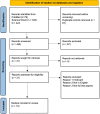A Systematic Review on Whether an Association Exists Between Adolescent Obesity and Idiopathic Intracranial Hypertension
- PMID: 36127965
- PMCID: PMC9477550
- DOI: 10.7759/cureus.28071
A Systematic Review on Whether an Association Exists Between Adolescent Obesity and Idiopathic Intracranial Hypertension
Abstract
Pseudotumor cerebri syndrome (PTCS)/idiopathic intracranial hypertension (IIH) is a clinical presentation appertaining to signs/symptoms of raised intracranial pressure, like headache and papilledema. It is an uncommon but clinically significant cause of morbidity such as permanent vision loss. It is crucial to understand if idiopathic intracranial hypertension (IIH) is on the rise in adolescents, it is probably due to the rising prevalence of obesity worldwide. Our study aimed to find an association between obesity and IIH in adolescents. We utilized Preferred Reporting Items for Systematic Review and Meta-Analysis 2020 (PRISMA) guidelines to run this systematic review. Many publications related to the topic in the discussion were scrutinized through a comprehensive database search. We filtered them down to a final count of 10 articles after utilizing our inclusion/exclusion criteria and assessing the quality of work. In these final papers, we identified several possibilities to explain the link between obesity and IIH in adolescents. Overweight and obese adolescents were found to have a significantly increased risk of IIH development, with a more severe clinical picture seen in morbidly obese female patients.
Keywords: adolescent obesity; headache; idiopathic intracranial hypertension; lumbar puncture; obesity; overweight; papilledema; pseudotumor cerebri; ptcs; vision loss.
Copyright © 2022, Zafar et al.
Conflict of interest statement
The authors have declared that no competing interests exist.
Figures



Similar articles
-
Thinning of the Skull Base and Calvarial Thickness in Patients With Idiopathic Intracranial Hypertension.J Neuroophthalmol. 2022 Jun 1;42(2):192-198. doi: 10.1097/WNO.0000000000001504. Epub 2022 Feb 15. J Neuroophthalmol. 2022. PMID: 35195543
-
Headache in an Obese Adolescent Male: A Nonclassical Presentation of an Uncommon Disease.Glob Pediatr Health. 2018 Jul 10;5:2333794X18785550. doi: 10.1177/2333794X18785550. eCollection 2018. Glob Pediatr Health. 2018. PMID: 30014011 Free PMC article.
-
Prevalence of idiopathic intracranial hypertension and associated factors in obese children and adolescents.J Pediatr Endocrinol Metab. 2016 Aug 1;29(8):907-14. doi: 10.1515/jpem-2015-0470. J Pediatr Endocrinol Metab. 2016. PMID: 27464033
-
Idiopathic intracranial hypertension in the Middle East: A growing concern.Saudi J Ophthalmol. 2015 Jan-Mar;29(1):26-31. doi: 10.1016/j.sjopt.2014.09.013. Epub 2014 Sep 28. Saudi J Ophthalmol. 2015. PMID: 25859136 Free PMC article. Review.
-
Idiopathic Intracranial Hypertension - Challenges and Pearls.Neurol India. 2021 Nov-Dec;69(Supplement):S434-S442. doi: 10.4103/0028-3886.332276. Neurol India. 2021. PMID: 35103000 Review.
Cited by
-
Definition and diagnostic criteria of clinical obesity.Lancet Diabetes Endocrinol. 2025 Mar;13(3):221-262. doi: 10.1016/S2213-8587(24)00316-4. Epub 2025 Jan 14. Lancet Diabetes Endocrinol. 2025. PMID: 39824205 Review.
-
Isolated Intracranial Hypertensions as Onset of Myelin Oligodendrocyte Glycoprotein Antibody Disease.J Clin Med. 2024 Jul 30;13(15):4468. doi: 10.3390/jcm13154468. J Clin Med. 2024. PMID: 39124735 Free PMC article.
-
Frontonasal Encephalocele Complicated With Pseudotumor Cerebri: A Case Report and Literature Review.Cureus. 2023 Sep 18;15(9):e45509. doi: 10.7759/cureus.45509. eCollection 2023 Sep. Cureus. 2023. PMID: 37868498 Free PMC article.
-
The relationship between body mass index and cerebrospinal fluid pressure in children with pseudotumor cerebri.Ital J Pediatr. 2024 Aug 17;50(1):150. doi: 10.1186/s13052-024-01722-w. Ital J Pediatr. 2024. PMID: 39154176 Free PMC article.
References
-
- Revised diagnostic criteria for the pseudotumor cerebri syndrome in adults and children. Friedman DI, Liu GT, Digre KB. Neurology. 2013;81:1159–1165. - PubMed
-
- Symptoms and disease associations in idiopathic intracranial hypertension (pseudotumor cerebri): a case-control study. Giuseffi V, Wall M, Siegel PZ, Rojas PB. Neurology. 1991;41:239–244. - PubMed
-
- Idiopathic intracranial hypertension in children: the Iowa experience. Babikian P, Corbett J, Bell W. J Child Neurol. 1994;9:144–149. - PubMed
Publication types
LinkOut - more resources
Full Text Sources
Medical
